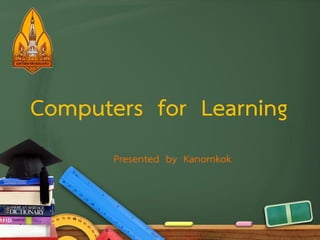Computers for learning
- 1. Computers for Learning Presented by Kanomkok
- 3. ÓĖ¬ÓĖ¢ÓĖ▓ÓĖÖÓĖüÓĖ▓ÓĖŻÓĖōÓ╣īÓĖøÓĖ▒ÓĖŹÓĖ½ÓĖ▓(Problem-based learning) Ó╣éÓĖŻÓĖćÓ╣ĆÓĖŻÓĖĄÓĖóÓĖÖÓĖÜÓ╣ēÓĖ▓ÓĖÖÓĖ½ÓĖÖÓĖŁÓĖćÓ╣āÓĖ½ÓĖŹÓ╣łÓ╣äÓĖöÓ╣ēÓĖŻÓĖ▒ÓĖÜÓĖüÓĖ▓ÓĖŻÓĖÜÓĖŻÓĖ┤ÓĖłÓĖ▓ÓĖäÓĖ½Ó╣ēÓĖŁÓĖćÓĖäÓĖŁÓĖĪÓĖ×ÓĖ┤ÓĖ¦Ó╣ĆÓĖĢÓĖŁÓĖŻÓ╣īÓ╣āÓĖ½ÓĖĪÓ╣ł ÓĖ½ÓĖźÓĖ▒ÓĖćÓĖłÓĖ▓ÓĖüÓĖŚÓĖĄÓ╣łÓ╣äÓĖöÓ╣ēÓĖĪÓĖĄ Ó╣éÓĖäÓĖŻÓĖćÓĖüÓĖ▓ÓĖŻÓĖ£Ó╣ē ÓĖ▓ ÓĖøÓ╣łÓĖ▓ ÓĖŗÓĖĘÓ╣ēÓĖŁÓĖäÓĖŁÓĖĪÓĖ×ÓĖ┤ ÓĖ¦Ó╣ĆÓĖĢÓĖŁÓĖŻÓ╣ī Ó╣āÓĖ½Ó╣ēÓĖüÓĖ▒ÓĖÜ Ó╣éÓĖŻÓĖćÓ╣ĆÓĖŻÓĖĄ ÓĖóÓĖÖ ÓĖŗÓĖČÓ╣łÓĖć ÓĖ£ÓĖŁ.Ó╣éÓĖŻÓĖćÓ╣ĆÓĖŻÓĖĄ ÓĖóÓĖÖÓĖłÓĖČÓĖćÓ╣äÓĖöÓ╣ē ÓĖĪÓĖĄÓĖÖÓ╣éÓĖóÓĖÜÓĖ▓ÓĖóÓ╣āÓĖ½Ó╣ēÓĖäÓĖŻÓĖ╣ ÓĖŚÓĖĖÓĖü ÓĖŻÓĖ░ÓĖöÓĖ▒ÓĖÜÓĖŖÓĖ▒Ó╣ēÓĖÖÓĖ×ÓĖ▒ÓĖÆÓĖÖÓĖ▓ÓĖ¬ÓĖĘÓ╣łÓĖŁÓĖüÓĖ▓ÓĖŻÓĖ¬ÓĖŁÓĖÖÓ╣éÓĖöÓĖóÓ╣āÓĖŖÓ╣ēÓĖäÓĖŁÓĖĪÓĖ×ÓĖ┤ÓĖ¦Ó╣ĆÓĖĢÓĖŁÓĖŻÓ╣ī ÓĖ½ÓĖŻÓĖĘÓĖŁÓĖ½ÓĖ▓ÓĖüÓ╣āÓĖäÓĖŻÓĖŚÓĖĄÓ╣łÓĖóÓĖ▒ÓĖćÓ╣äÓĖĪÓ╣łÓĖ¬ÓĖ▓ÓĖĪÓĖ▓ÓĖŻÓĖ¢ÓĖ¬ÓĖŻÓ╣ēÓĖ▓ÓĖćÓ╣ĆÓĖŁÓĖćÓ╣äÓĖöÓ╣ēÓĖüÓ╣ćÓ╣āÓĖ½Ó╣ē ÓĖÜÓĖ╣ ÓĖŻ ÓĖōÓĖ▓ÓĖüÓĖ▓ÓĖŻÓĖäÓĖŁÓĖĪÓĖ×ÓĖ┤ ÓĖ¦ Ó╣ĆÓĖĢÓĖŁÓĖŻÓ╣ī Ó╣ā ÓĖÖÓĖüÓĖ▓ÓĖŻÓ╣ĆÓĖŻÓĖĄ ÓĖó ÓĖÖÓĖüÓĖ▓ÓĖŻÓĖ¬ÓĖŁÓĖÖ Ó╣üÓĖźÓĖ░Ó╣ĆÓĖøÓĖ┤ ÓĖö ÓĖŖÓ╣ł ÓĖ¦ ÓĖćÓ╣ĆÓĖ¦ÓĖźÓĖ▓Ó╣āÓĖ½Ó╣ē ÓĖÖÓĖ▒ ÓĖü Ó╣ĆÓĖŻÓĖĄ ÓĖó ÓĖÖÓ╣ĆÓĖéÓ╣ē ÓĖ▓ ÓĖĪÓĖ▓Ó╣āÓĖŖÓ╣ē ÓĖäÓĖŁÓĖĪÓĖ×ÓĖ┤ÓĖ¦Ó╣ĆÓĖĢÓĖŁÓĖŻÓ╣īÓ╣äÓĖöÓ╣ē ÓĖ£ÓĖźÓĖłÓĖ▓ÓĖüÓĖüÓĖ▓ÓĖŻÓĖøÓĖŻÓĖ░Ó╣ĆÓĖĪÓĖ┤ÓĖÖÓĖüÓĖ▓ÓĖŻÓ╣āÓĖŖÓ╣ēÓĖäÓĖŁÓĖĪÓĖ×ÓĖ┤ÓĖ¦Ó╣ĆÓĖĢÓĖŁÓĖŻÓ╣īÓĖéÓĖŁÓĖćÓ╣éÓĖŻÓĖćÓ╣ĆÓĖŻÓĖĄÓĖóÓĖÖÓ╣āÓĖÖÓĖøÓĖĄÓĖŚÓĖĄÓ╣łÓĖ£Ó╣łÓĖ▓ÓĖÖÓĖĪÓĖ▓ÓĖ×ÓĖÜÓĖ¦Ó╣łÓĖ▓ ÓĖäÓĖŻÓĖ╣ ÓĖ×ÓĖ▒ÓĖÆÓĖÖÓĖ▓ÓĖ¬ÓĖĘÓ╣łÓĖŁÓĖäÓĖŁÓĖĪÓĖ×ÓĖ┤ÓĖ¦Ó╣ĆÓĖĢÓĖŁÓĖŻÓ╣īÓ╣āÓĖÖÓĖźÓĖ▒ÓĖüÓĖ®ÓĖōÓĖ░ÓĖŚÓĖĄÓ╣łÓ╣ĆÓĖøÓ╣ćÓĖÖÓ╣ĆÓĖäÓĖŻÓĖĘÓ╣łÓĖŁÓĖćÓĖĪÓĖĘÓĖŁÓ╣āÓĖÖÓĖüÓĖ▓ÓĖŻÓĖ¢Ó╣łÓĖ▓ÓĖóÓĖŚÓĖŁÓĖöÓ╣üÓĖźÓĖ░ÓĖÖÓĖ▓Ó╣ĆÓĖ¬ÓĖÖÓĖŁÓ╣ĆÓĖÖÓĖĘÓ╣ēÓĖŁÓĖ½ÓĖ▓ÓĖüÓĖ▓ÓĖŻ Ó╣ĆÓĖŻÓĖĄÓĖóÓĖÖÓĖüÓĖ▓ÓĖŻÓĖ¬ÓĖŁÓĖÖÓ╣éÓĖöÓĖóÓĖĢÓĖŻÓĖćÓ╣äÓĖøÓĖóÓĖ▒ÓĖćÓĖ£ÓĖ╣Ó╣ēÓ╣ĆÓĖŻÓĖĄÓĖóÓĖÖ Ó╣éÓĖöÓĖóÓ╣āÓĖÖÓĖÜÓĖŚÓ╣ĆÓĖŻÓĖĄÓĖóÓĖÖÓĖäÓĖŁÓĖĪÓĖ×ÓĖ┤ÓĖ¦Ó╣ĆÓĖĢÓĖŁÓĖŻÓ╣īÓĖĪÓĖĄÓĖüÓĖ▓ÓĖŻÓĖŚÓĖöÓĖ¬ÓĖŁÓĖÜ ÓĖüÓĖ▓ÓĖŻÓĖÖÓĖ▓Ó╣ĆÓĖ¬ÓĖÖÓĖŁ Ó╣ĆÓĖÖÓĖĘÓ╣ēÓĖŁÓĖ½ÓĖ▓ ÓĖüÓĖ▓ÓĖŻÓĖŚÓĖöÓĖ¬ÓĖŁÓĖÜÓĖ½ÓĖźÓĖ▒ ÓĖćÓ╣ĆÓĖŻÓĖĄ ÓĖóÓĖÖ ÓĖÜÓĖŚÓĖÜÓĖ▓ÓĖŚÓĖ£ÓĖ╣Ó╣ē Ó╣ĆÓĖŻÓĖĄ ÓĖóÓĖÖÓĖüÓ╣ć ÓĖóÓĖ▒ÓĖćÓ╣ĆÓĖøÓ╣ćÓĖÖÓ╣ĆÓĖ×ÓĖĄ ÓĖóÓĖćÓ╣üÓĖäÓ╣łÓĖü ÓĖ▓ÓĖŻÓĖŚÓ╣łÓĖŁÓĖćÓĖłÓĖ▓Ó╣ĆÓĖÖÓĖĘÓ╣ēÓĖŁÓĖ½ÓĖ▓ ÓĖŗÓĖČÓ╣łÓĖćÓ╣äÓĖĪÓ╣ł ÓĖ¬Ó╣łÓĖćÓ╣ĆÓĖ¬ÓĖŻÓĖ┤ÓĖĪÓĖüÓĖŻÓĖ░ÓĖÜÓĖ¦ÓĖÖÓĖüÓĖ▓ÓĖŻÓĖäÓĖ┤ÓĖö ÓĖøÓĖ▒ÓĖŹÓĖ½ÓĖ▓ÓĖŁÓĖĄÓĖüÓĖøÓĖŻÓĖ░ÓĖüÓĖ▓ÓĖŻÓĖŚÓĖĄÓ╣łÓĖ×ÓĖÜÓĖäÓĖĘÓĖŁ Ó╣ĆÓĖĪÓĖĘÓ╣łÓĖŁÓĖäÓĖŻÓĖ╣ÓĖłÓĖ▒ÓĖöÓĖüÓĖ┤ÓĖłÓĖüÓĖŻÓĖŻÓĖĪÓ╣āÓĖ½Ó╣ēÓĖ£ÓĖ╣Ó╣ēÓ╣ĆÓĖŻÓĖĄÓĖóÓĖÖÓ╣ĆÓĖéÓ╣ēÓĖ▓Ó╣äÓĖøÓ╣āÓĖŖÓ╣ēÓĖäÓĖŁÓĖĪÓĖ×ÓĖ┤ÓĖ¦Ó╣ĆÓĖĢÓĖŁÓĖŻÓ╣īÓĖüÓ╣ć ÓĖĪÓĖ▒ÓĖüÓĖłÓĖ░Ó╣āÓĖŖÓ╣ēÓ╣ĆÓĖ×ÓĖĘÓ╣łÓĖŁÓ╣ĆÓĖźÓ╣łÓĖÖÓ╣ĆÓĖüÓĖĪ ÓĖöÓĖ╣ÓĖ½ÓĖÖÓĖ▒ÓĖć ÓĖ¬ÓĖÖÓĖŚÓĖÖÓĖ▓ÓĖŁÓĖŁÓĖÖÓ╣äÓĖźÓĖÖÓ╣ī Ó╣üÓĖźÓĖ░ Social media Ó╣éÓĖöÓĖóÓ╣ĆÓĖēÓĖ×ÓĖ▓ÓĖ░ face book ÓĖŗÓĖČÓ╣łÓĖćÓ╣äÓĖĪÓ╣łÓ╣äÓĖöÓ╣ēÓ╣āÓĖŖÓ╣ēÓĖäÓĖŁÓĖĪÓĖ×ÓĖ┤ÓĖ¦Ó╣ĆÓĖĢÓĖŁÓĖŻÓ╣īÓ╣ĆÓĖøÓ╣ćÓĖÖÓ╣ĆÓĖäÓĖŻÓĖĘÓ╣łÓĖŁÓĖćÓĖĪÓĖĘÓĖŁÓ╣āÓĖÖÓĖüÓĖ▓ÓĖŻÓ╣üÓĖ¬ÓĖ¦ÓĖćÓĖ½ÓĖ▓Ó╣üÓĖźÓĖ░ÓĖ¬ÓĖŻÓ╣ēÓĖ▓ÓĖć ÓĖüÓĖ▓ÓĖŻÓ╣ĆÓĖŻÓĖĄÓĖóÓĖÖÓĖŻÓĖ╣Ó╣ēÓĖéÓĖŁÓĖćÓĖĢÓĖÖÓ╣ĆÓĖŁÓĖć
- 4. Mission 1 How students will be guided in the use of computers to solve problems of the Ban Nong Yai school ? Problem 1 Teachers in the development of computer as a tool to convey and deliver instructional content directly to the students. The role of the learner is also simply memorizing content which does not promote the process of idea.
- 5. Mission 1 How students will be guided in the use of computers to solve problems of the Ban Nong Yai school ? Solve - Teachers should be trained to develop the computer skills. - Teachers create activities for learners to learn by themselves.
- 6. Mission 1 How students will be guided in the use of computers to solve problems of the Ban Nong Yai school ? Problem 2 Teacher organize activities for the students to use computers, they are typically used for playing games, watching movies, chat and social media in particular face book which does not use the computer as a tool to seek and create their own learning.
- 7. Mission 1 How students will be guided in the use of computers to solve problems of the Ban Nong Yai school ? Solve - Teachers and students helped to create the rules for using the computer. - Integrate content and learning process to a website that interest or might draw the attention of students from issues in website
- 8. Mission 2 How role of computer as a tool on learning ? ’ü▒ Discover tools Tools support search for information conduct required knowledge.
- 9. Seeking tools ’é¦ Search engines ’é¦ maps
- 10. Collecting tools ’é¦ Saving ’é¦ Downloading ’é¦ Bookmaking
- 11. ’ü▒ Knowledge creation tools Tools support building knowledge of learners in short-term memory
- 12. Organizing tools ’é¦ Flow chart ’é¦ Mind mapping ’é¦ Constructing table
- 13. Integrating tools ’é¦ Animation ’é¦ Simulation
- 14. Generating tools ’é¦ Lego ’é¦ Micro world
- 15. ’ü▒ Communication tools Tools support conceptual discussion between students themselves and teacher
- 16. Synchronous communication tools ’é¦ LINE ’é¦ Chat ’é¦ Online conference
- 17. Asynchronous communication tools ’é¦ E-mail ’é¦ Web board
- 18. Mission 3 Design about using computer as a tool to enhance instruction ŌĆó To understand chemistry conceptually, phenomena must be related at observable, symbolic and microscopic levels ŌĆó Students encounter misconceptions especially on microscopic and symbolic levels.
- 19. Mission 3 Design about using computer as a tool to enhance instruction ŌĆó Instructors have used various strategies including animations or computer simulation to help students visualize the microscopic level Students seeking evidence by laboratory And use a computer simulation to further their understanding
- 21. Members ’é¦ Miss Kanokkhwan ’é¦ Miss Jaroonlak ’é¦ Mr. Teetawat ’é¦ Miss Chunthanet ’é¦ Miss Sarunya ’é¦ Mr. Proranat ’é¦ Miss Pattiya Marayat Worakhot Najantad Nasaro Pinatuwong Yakum Pong-aram 565050305-4 565050310-1 565050315-1 565050327-4 565050340-2 565050278-1 565050281-2









































































